The year 2022 will be remembered across the U.S. for its devastating flooding and storms — and also for its extreme heat waves and droughts, including one so severe it briefly shut down traffic on the Mississippi River.
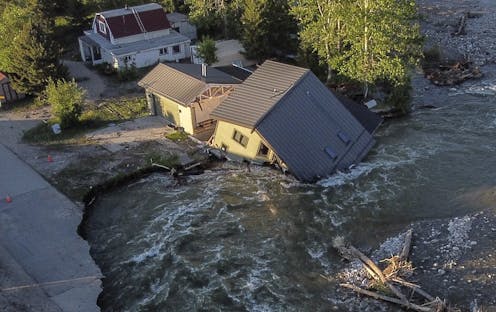 Rain and fast snowmelt sent the Yellowstone River and nearby streams raging beyond their banks in June 2022. AP Photo/David Goldman
Rain and fast snowmelt sent the Yellowstone River and nearby streams raging beyond their banks in June 2022. AP Photo/David Goldman
During a period of five weeks over the summer, five 1,000-year rainfall events occurred in St. Louis, eastern Kentucky, southern Illinois, California’s Death Valley and Dallas, causing devastating and sometimes deadly flash floods. Severe flooding in Mississippi knocked out Jackson’s troubled water supply for weeks. A historic flood in Montana, brought on by heavy rain and melting snow, forced large areas of Yellowstone National Park to be evacuated.
People are also reading…
- New owners to maintain longstanding ice cream tradition at Rakestraw's in Mechanicsburg
- 2022 All-Sentinel Football Team: Cumberland Valley's Isaac Sines, Mechanicsburg's Sage Thomas lead the way as Players of the Year
- South Middleton School Board approves job description, continues debate for adding security supervisor/officer
- Winner of ‘Survivor’ 43 says he will donate entire $1 million prize to help veterans
- UPDATE: Man missing in Pine Grove Furnace State Park located
- Boiling Springs boys basketball to honor 1980 championship team, all-state players at Alumni Tournament
- 'It's kind of full circle': Cumberland Valley cheerleading secures 13th straight District 3 title
- Closed since 2018, historic Hertzler Bridge reopens to traffic in Cumberland County
- Sentinel police log for Dec. 20
- Stephen 'tWitch' Boss reportedly 'left suicide note', Rihanna shares TikTok of baby boy, and more celeb news
- Sudden victory for Herd's Mitchell Adams headlines 4 local titles at Carlisle Classic Wrestling Tournament
- Brie Droege scores 31 points to lead Columbia girls basketball in 53-48 win at Trinity
- Sentinel police log for Dec. 19
- UPDATE: Missing Silver Spring man located
- Ghosts of Shopping Past Day 11: Cole’s Bicycles in Carlisle
In the fall, hurricanes Ian and Fiona deluged Florida and Puerto Rico with over 2 feet (6.6 meters) of rain in areas and deadly, destructive storm surge. Ian became one of the most expensive hurricanes in U.S. history. And a typhoon pounded 1,000 miles (1,600 km) of the Alaska coast.
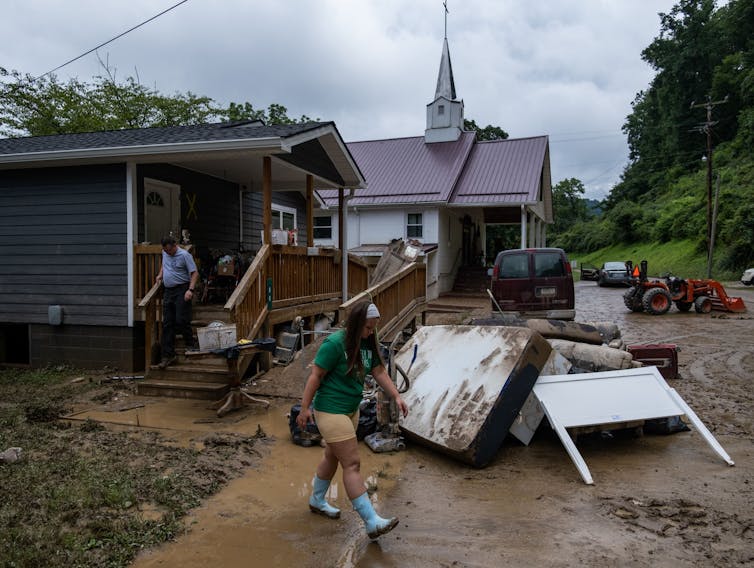 Flash flooding swept through mountain valleys in eastern Kentucky in July 2022, killing more than three dozen people. It was one of several destructive flash floods. Seth Herald/AFP via Getty Images
Flash flooding swept through mountain valleys in eastern Kentucky in July 2022, killing more than three dozen people. It was one of several destructive flash floods. Seth Herald/AFP via Getty Images
While too much rainfall threatened some regions, extreme heat and too little precipitation worsened risks elsewhere.
Persistent heat waves lingered over many parts of the country, setting temperature records. Wildfires raged in Arizona and New Mexico on the background of a megadrought in the Southwestern U.S. more severe than anything the region has experienced in at least 1,200 years.
Listen now and subscribe: Apple Podcasts | Google Podcasts | Spotify | RSS Feed | Omny Studio
Drought also left the Mississippi River so low near Memphis in the fall that barges couldn’t get through without additional dredging and upstream water releases. That snarled grain shipping during the critical harvest period. Along the Colorado River, officials discussed even tighter water use restrictions as water levels neared dangerously low levels in the major reservoirs.
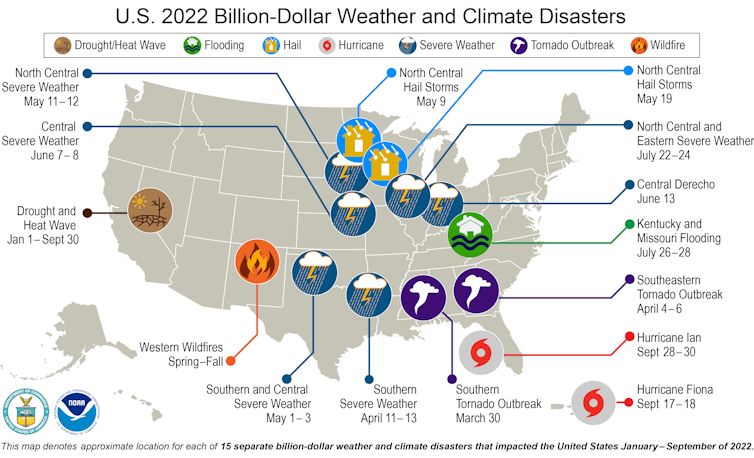 The U.S. had been hit with 15 climate and weather disasters costing over US$1 billion each by the end of September 2022. The map shows disasters from January through September. NCEI/NOAA
The U.S. had been hit with 15 climate and weather disasters costing over US$1 billion each by the end of September 2022. The map shows disasters from January through September. NCEI/NOAA
The United States was hardly alone in its climate disasters.
In Pakistan, record monsoon rains inundated more than one-third of the country, killing over 1,500 people. In India and China, prolonged heat waves and droughts dried up rivers, disrupted power grids and threatened food security for billions of people. Widespread flooding and mudslides brought on by torrential rains also killed hundreds of people in South Africa, Brazil and Nigeria.
In Europe, heat waves set record temperatures in Britain and other parts of the continent, leading to severe droughts, low river flows that slowed shipping, and wildfires in many parts of the continent. Much of East Africa is still in the grips of a multiyear drought – the worst in over 40 years, according to the United Nations – leaving millions of people vulnerable to food shortages and starvation.
This isn’t just a freak year: Such extreme events are occurring with increasing frequency and intensity.
Climate change is intensifying these disasters
The most recent global climate assessment from the United Nations Intergovernmental Panel on Climate Change found significant increases in both the frequency and intensity of extreme temperature and precipitation events, leading to more droughts and floods.
Extreme flooding and droughts are also getting deadlier and more expensive, despite an improving capacity to manage climate risks, a study published in 2022 found. Part of the reason is that today’s extreme events, enhanced by climate change, often exceed communities’ management capabilities.
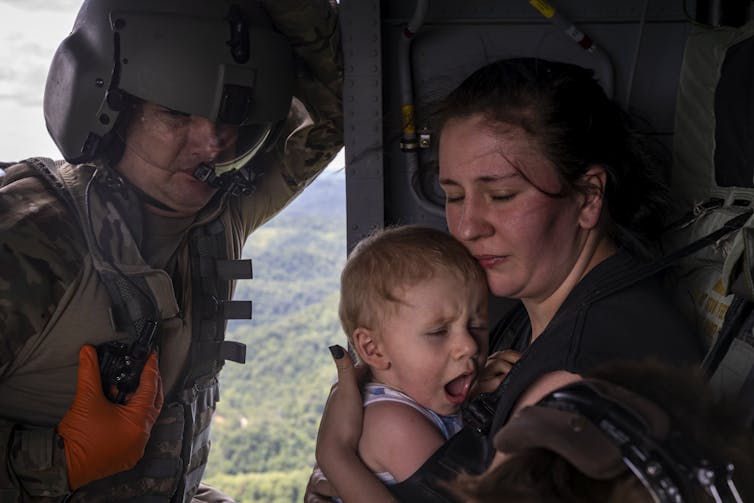 A family had to be airlifted from their home in eastern Kentucky after it was surrounded by floodwater in July 2022. Michael Swensen/Getty Images
A family had to be airlifted from their home in eastern Kentucky after it was surrounded by floodwater in July 2022. Michael Swensen/Getty Images
Listen now and subscribe: Apple Podcasts | Google Podcasts | Spotify | RSS Feed | Omny Studio
Extreme events, by definition, occur rarely. A 100-year flood has a 1% chance of happening in any given year. So when such events occur with increasing frequency and intensity, they are a clear indication of a changing climate state.
Climate models showed these risks were coming
Much of this is well understood and consistently reproduced by climate models.
As the climate warms, a shift in temperature distribution leads to more extremes. For example, globally, a 1 degree Celsius increase in annual average temperature is associated with a 1.2 C to 1.9 C (2.1 Fahrenheit to 3.4 F) increase in the annual maximum temperature.
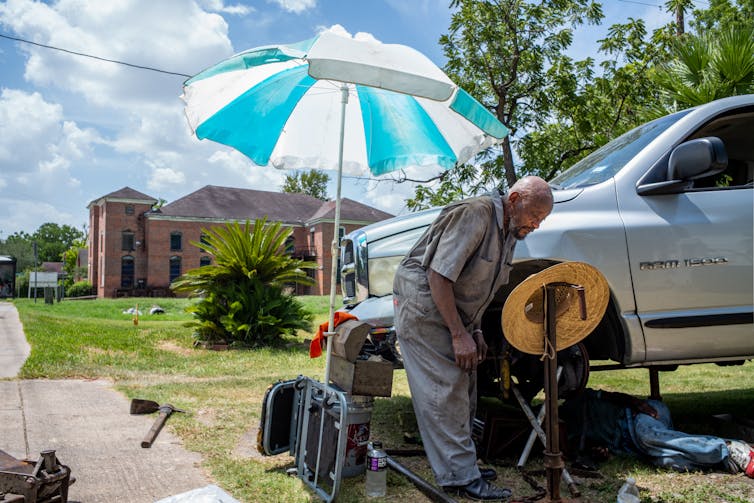 Heat waves, like the heat dome over the South in July 2022, can hit outdoor workers especially hard. Brandon Bell/Getty Images
Heat waves, like the heat dome over the South in July 2022, can hit outdoor workers especially hard. Brandon Bell/Getty Images
In addition, global warming leads to changes in how the atmosphere and ocean move. The temperature difference between the equator and the poles is the driving force for global wind. As the polar regions warm at much higher rates than the equator, the reduced temperature difference causes a weakening of global winds and leads to a more meandering jet stream.
Some of these changes can create conditions such as persistent high-pressure systems and atmospheric blocking that bring more intense heat waves. The heat domes over the Southern Plains and South in June and in the West in September were both examples.
For example, higher temperatures tend to dry out the soil, and less soil moisture reduces the land’s heat capacity, making it easier to heat up. More frequent and persistent heat waves lead to excessive evaporation, combined with decreased precipitation in some regions, causing more severe droughts and more frequent wildfires.
Higher temperatures increase the atmosphere’s capacity to hold moisture at a rate of about 7% per degree Celsius. This increased humidity leads to heavier rainfall events.
In addition, storm systems are fueled by latent heat – the large amount of energy released when water vapor condenses to liquid water. Increased moisture content in the atmosphere also enhances latent heat in storm systems, increasing their intensity. Extreme heavy or persistent rainfall leads to increased flooding and landslides, with devastating social and economic consequences.
Even though it’s difficult to link specific extreme events directly to climate change, when these supposedly rare events occur with greater frequency in a warming world, it is hard to ignore the changing state of our climate.
The new abnormal
This year might provide a glimpse of our near future, as these extreme climate events become more frequent.
To say this is the “new normal,” though, is misleading. It suggests that we have reached a new stable state, and that is far from the truth. Without serious effort to curb greenhouse gas emissions, this trend toward more extreme events will continue.
This updates an article originally published on Sept. 21, 2022.
Shuang-Ye Wu does not work for, consult, own shares in or receive funding from any company or organisation that would benefit from this article, and has disclosed no relevant affiliations beyond their academic appointment.
This article is republished from The Conversation under a Creative Commons license.
64% of Americans are now exposed to extreme heat. Here's why that's worrying
64% of Americans are now exposed to extreme heat. Here's why that's worrying
The infamous Dust Bowl years of the 1930s saw unprecedented extreme heat waves decimate the Midwest and the Great Plains. Temperatures climbed to well over 100 degrees Fahrenheit in states used to a relatively cool climate. Over the span of six years, roughly 5,000 people died from heat-related causes, and intense drought made agricultural efforts nearly impossible.
The Dust Bowl heat waves were something of an anomaly at the time, as there was little climate science at that time to explain the event. However, climate scientists today have reflected on the event as one of the first human-influenced climate events, triggered by coal-reliant industrialization, and as a harbinger of climate change.
Today, record-breaking heat waves have emerged with alarming frequency and more intensity than ever before. People in cities used to temperate or cool summers across the U.S. have been contending with temperatures more suited to Death Valley. Meanwhile, heat waves are becoming even more intense in already-hot locales, including the Sun Belt. Despite this, Americans are moving to Southern states at high rates, increasing the number of people who will be exposed to extreme heat.
To investigate how extreme heat is impacting cities across the country, OhmConnect compiled a list of how heat waves in major U.S. cities have changed over time, with data from sources including the Environmental Protection Agency, the World Health Organization, the Center for Climate and Energy Solutions, Globalchange.gov, and other scientific research. The data available is from 1961 to 2021 across 50 large metropolitan areas.
Heat waves have become more frequent across major US cities
U.S. cities are experiencing more heat waves every year. In the 1960s, cities endured an average of two heat waves per year. That number has grown to an average of six each year during the 2010s and 2020s, according to the EPA. Cities are particularly vulnerable to more heat waves because of factors like urban heat islands, an effect that makes urban areas hotter than surrounding rural regions. Many factors contribute to urban heat islands: darker surfaces like asphalt and roof shingles—which absorb rather than reflect heat—less shade from trees, and fewer plants emitting cooling moisture from their leaves.
Current heat wave seasons last 49 days longer than they did in the 1960s
In addition to heat waves becoming more frequent, heat wave seasons have also become longer. In the 1960s, heat wave seasons lasted an average of 24 days a year. In the 2020s, that number has risen to more than 70 days a year. The expansion of heat wave seasons can be dangerous, since it widens the window for extreme temperatures during unusual times of the year. This can lead to situations in which people are not prepared, leaving them vulnerable.
The increased frequency of heat waves and length of heat wave seasons has inspired some cities to take action. In 2021, the mayor of Miami-Dade County appointed a chief heat officer, the first in the nation. This position is intended to strategize ways of keeping people safe from increasingly intense heat events in a city that is experiencing some of the worst heat waves in the country.
The average heat wave lasts about 4 days, a day longer than in the 1960s
Longer heat waves have grave consequences for people's health and safety, particularly for those who are unhoused or who don't have access to air conditioning. Living for prolonged periods at very high temperatures without being able to cool off can increase the risk of heat-related illness and even death. To make matters worse, record-breaking heat during the nighttime has been reported across the country, removing the usual respite from heat offered by the sun going down, and adding to the danger already caused by several days of extreme temperatures.
Temperature increases are now more extreme
The intensity of heat waves has steadily climbed over the past six decades. Both in regions accustomed to some amount of extreme temperatures, like the South, as well as in areas which have not previously experienced high temperatures, heat waves have become hotter and more deadly.
In 2021, the Pacific Northwest, a region known for its moderate weather, saw a blistering heat wave that peaked between 116 and 118 degrees Fahrenheit. The event caught many people unprepared, and hundreds of deaths were reported in Oregon and Washington, particularly among people who did not have access to air conditioning. Other cities in California and other parts of the Western U.S. experienced extreme heat waves in September 2022, making it the hottest September on record for the West.
Dehydration and weather-related deaths are on the rise
Heat is the leading extreme weather-related cause of death in the U.S. The EPA estimates that between 600 and 1,300 deaths occur in the U.S. every year from extreme heat. Heat-related illnesses and deaths can happen when the body loses its ability to regulate its internal temperature. Dehydration and increased internal temperature can cause blood thickening, which leads to organ and heart damage.
Agriculture and energy: a point of no return
Extreme heat waves impact much more than people's ability to be outside without air conditioning. They also have serious environmental, agricultural, and energy-related ramifications. Heat waves harm crops, cause issues with plant growth, and make it difficult for livestock to survive. They also exacerbate drought, creating water shortages and conditions that are conducive to wildfires and other natural disasters.
Energy systems can also be strained by an increased need for high-energy utilities like air conditioning, with demand outstripping supply in some cases. In July 2022, Texans were instructed to conserve as much energy as possible to alleviate strain on the power grid as temperatures neared 110 F.
Preparation is key to facing extreme temperatures
As extreme heat events continue to become more frequent and severe, experts caution that being prepared for intense heat waves is one of the best ways to keep people safe. On an institutional level, the CDC recommends having early heat wave alerts in place on a city or county level to warn residents of impending extreme heat risks. This would also enable public cooling centers to open at appropriate times, a vital measure for those without air conditioning and people experiencing homelessness. Keeping hydrated and avoiding the outdoors during heat waves is especially important.
At the same time, measures can be taken to prevent the continued rise of temperatures, as well as to mediate the risks of straining energy systems. Increasing energy efficiency and forms of renewable energy would prevent power grids from being overwhelmed while limiting further emissions, which contribute to rising temperatures in the first place. Introducing more trees and vegetation to urban areas could also work to introduce shade, increase air quality and reduce the harm of emissions, and limit the impact of urban heat islands.
This story originally appeared on OhmConnect and was produced and distributed in partnership with Stacker Studio.
Local Weather
Get the daily forecast and severe weather alerts in your inbox!




